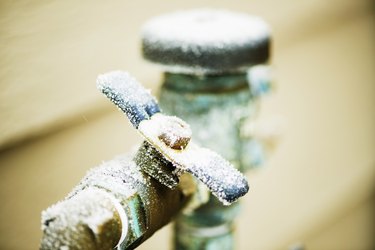We have found this great article on Helpful Tips to Prevent Frozen Pipes this Winter listed below on the web and concluded it made perfect sense to write about it with you in this article.
:strip_icc()/snow-outdoor-faucet-pipes-4af65d1e5e904fb1aa7bf74071fe5d89.jpg)
Cold weather can damage your plumbing, especially by freezing pipelines. Below's how to avoid it from taking place and what to do if it does.
Intro
As temperature levels decline, the risk of icy pipes increases, possibly bring about pricey repair services and water damage. Understanding just how to prevent icy pipes is essential for home owners in chilly environments.
Comprehending Icy Pipes
What creates pipes to ice up?
Pipelines ice up when exposed to temperature levels below 32 ° F (0 ° C) for prolonged durations. As water inside the pipes freezes, it increases, putting pressure on the pipe walls and possibly causing them to burst.
Dangers and damages
Frozen pipes can bring about water system disruptions, home damage, and costly repairs. Burst pipelines can flooding homes and cause comprehensive architectural damages.
Signs of Frozen Pipeline
Determining icy pipes early can stop them from rupturing.
How to determine icy pipes
Try to find lowered water flow from faucets, uncommon odors or noises from pipes, and visible frost on exposed pipes.
Prevention Tips
Shielding vulnerable pipelines
Cover pipelines in insulation sleeves or utilize warmth tape to shield them from freezing temperature levels. Focus on pipelines in unheated or outside areas of the home.
Heating strategies
Maintain interior areas appropriately warmed, specifically areas with plumbing. Open up closet doors to enable warm air to circulate around pipelines under sinks.
Securing Outside Plumbing
Yard pipes and outdoor taps
Detach and drain garden hose pipes before winter. Mount frost-proof spigots or cover outdoor faucets with insulated caps.
What to Do If Your Pipes Freeze
Immediate activities to take
If you believe icy pipes, maintain faucets available to ease stress as the ice melts. Use a hairdryer or towels soaked in warm water to thaw pipes slowly.
Long-Term Solutions
Structural changes
Think about rerouting pipes away from exterior wall surfaces or unheated areas. Include additional insulation to attic rooms, cellars, and crawl spaces.
Upgrading insulation
Invest in top quality insulation for pipes, attics, and wall surfaces. Correct insulation aids maintain regular temperatures and lowers the risk of frozen pipes.
Conclusion
Stopping icy pipes calls for proactive procedures and fast responses. By understanding the reasons, indications, and preventive measures, house owners can shield their plumbing during cold weather.
5 Ways to Prevent Frozen Pipes
Drain Outdoor Faucets and Disconnect Hoses
First, close the shut-off valve that controls the flow of water in the pipe to your outdoor faucet. Then, head outside to disconnect and drain your hose and open the outdoor faucet to allow the water to completely drain out of the line. Turn off the faucet when done. Finally, head back to the shut-off valve and drain the remaining water inside the pipe into a bucket or container. Additionally, if you have a home irrigation system, you should consider hiring an expert to clear the system of water each year.
Insulate Pipes
One of the best and most cost-effective methods for preventing frozen water pipes is to wrap your pipes with insulation. This is especially important for areas in your home that aren’t exposed to heat, such as an attic. We suggest using foam sleeves, which can typically be found at your local hardware store.
Keep Heat Running at 65
Your pipes are located inside your walls, and the temperature there is much colder than the rest of the house. To prevent your pipes from freezing, The Insurance Information Institute suggests that you keep your home heated to at least 65 degrees, even when traveling. You may want to invest in smart devices that can keep an eye on the temperature in your home while you’re away.
Leave Water Dripping
Moving water — even a small trickle — can prevent ice from forming inside your pipes. When freezing temps are imminent, start a drip of water from all faucets that serve exposed pipes. Leaving a few faucets running will also help relieve pressure inside the pipes and help prevent a rupture if the water inside freezes.
Open Cupboard Doors
Warm your kitchen and bathroom pipes by opening cupboards and vanities. You should also leave your interior doors ajar to help warm air circulate evenly throughout your home.

I'm just very inquisitive about 6 Ways to Prevent Frozen Pipes and I really hope you enjoyed reading the entire piece. If you enjoyed reading our post if you please do not forget to pass it around. I take joy in reading our article about Preventing and dealing with frozen pipes.
Call Today
Comments on “Essential Tips for Avoiding Frozen Pipes in Winter Conditions”